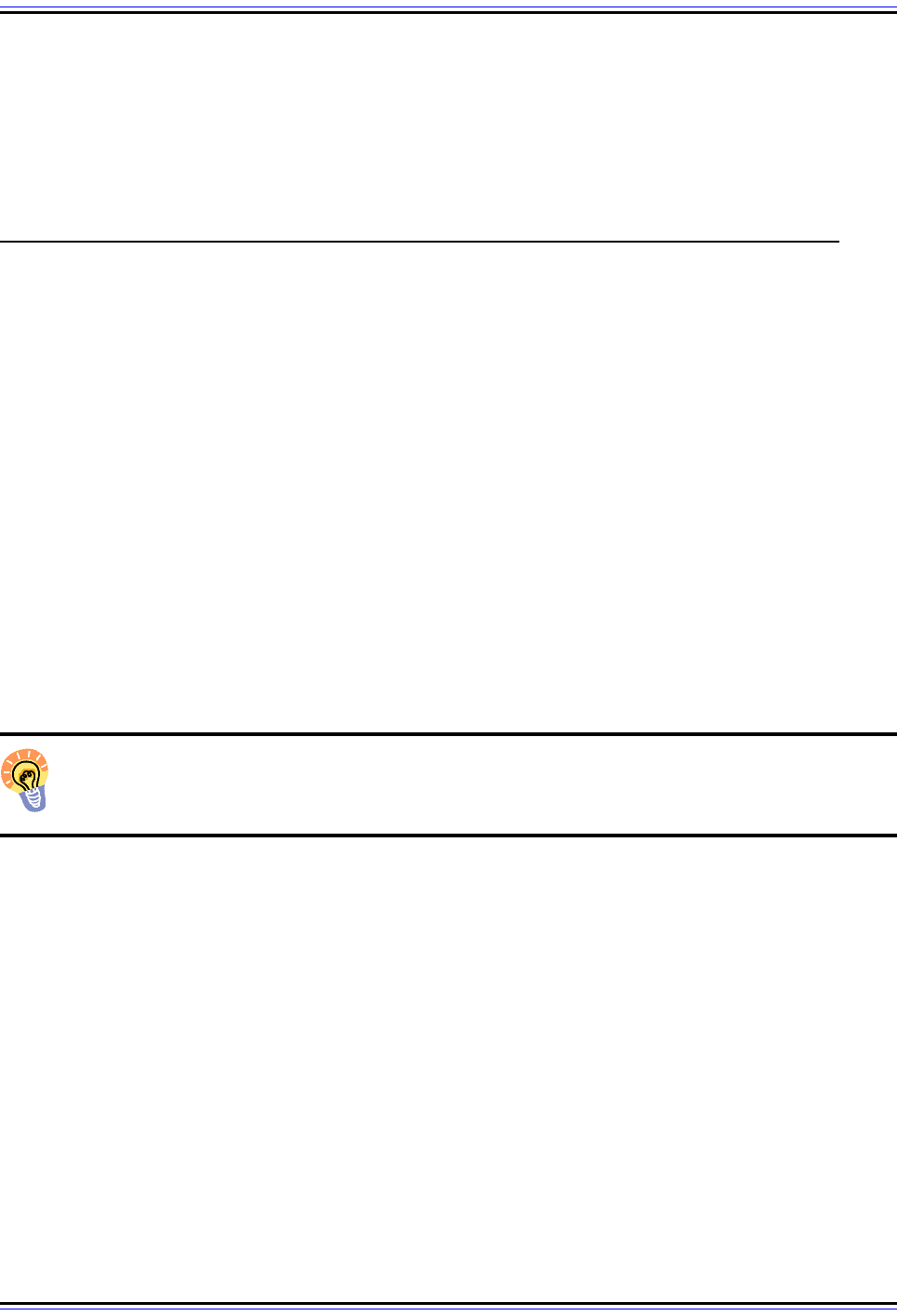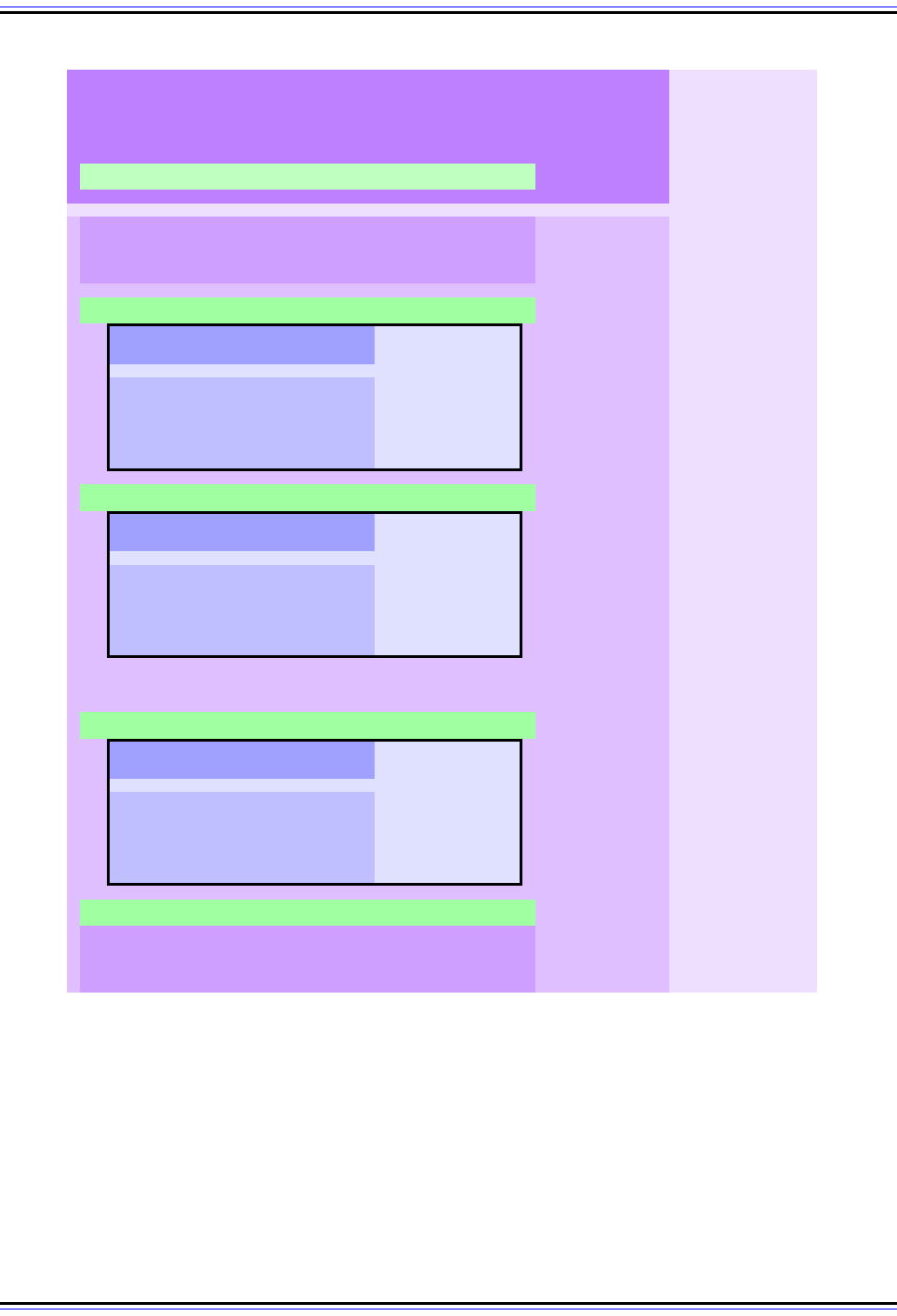Charles M. Kozierok The TCP-IP Guide
Подождите немного. Документ загружается.


The TCP/IP Guide - Version 3.0 (Contents) ` 1411 _ © 2001-2005 Charles M. Kozierok. All Rights Reserved.
This application/octet-stream type is also very often used for transmitting executable files
(programs) especially on Windows systems. Unfortunately, while convenient, this can be a
serious security hazard. In recent years, the Internet has been subject to a steady stream of
viruses and worms that spread by sending themselves to other users through executable
file attachments in e-mail. This makes opening and running any unknown application/octet-
stream attachment potentially dangerous.
MIME Composite Media Types: Multipart and Encapsulated Message Structures
MIME discrete media types allow MIME to represent hundreds of different kinds of data in
e-mail messages. This alone would make MIME an incredibly useful technology, but the
MIME standard goes one step further, by defining composite media types. These allow
MIME to perform even more “spectacular feats”, such as sending many types of data at
once, or encapsulating other messages or information into e-mail.
The use of a MIME composite media type is indicated via the Content-Type header of an
RFC 822 message. Instead of one of the six discrete media types (text, image, audio,
video, model and application), one of these two composite media types is used:
☯ Multipart Media Type (multipart): Allows one or more sets of data to be sent in a
single MIME message. Each piece of data is represented as an individual discrete
media type.
☯ Message Media Type (message): Allows a message to encapsulate another
message. This may be another e-mail message previously sent, or a message of
some other kind. This media type also provides flexibility for sending partial messages
and other special types of communication.
Key Concept: There are two MIME composite media types: message, which allows
one message to encapsulate another, and multipart, which allows multiple individual
media types to be encoded into a single e-mail message.
MIME Multipart Message Type
The multipart media type is the more common of the two, and for good reason: it is an
incredibly powerful mechanism. It allows one message to contain many different kinds of
information that can be used in different ways. Each piece of data is encoded separately as
a MIME body part and the parts are combined into a single e-mail message. How these
parts are used depends on the semantics of the message, which is indicated by the MIME
subtype. RFC 2046 describes several of these, and a few new ones have also been defined
by the IANA registration scheme described in the previous topic.
MIME Multipart Message Subtypes
The following are the most common multipart media subtypes, and how they are used. The
first four are defined in RFC 2046, and the others as indicated:

The TCP/IP Guide - Version 3.0 (Contents) ` 1412 _ © 2001-2005 Charles M. Kozierok. All Rights Reserved.
☯ multipart/mixed: Indicates that the body parts are not really related, but have just
been bundled for transport in a single message for convenience. For example, this
might be used by someone to send an office memo along with a vacation snapshot
just for fun. This subtype is also used sometimes when the parts are related but the
relationship is communicated to the recipient in some other way (such as a description
in a distinct body part).
☯ multipart/alternative: Specifies that the body parts are alternative representations of
the same information. The recipient decodes the parts and chooses the one that is
best suited to his or her needs. A common use of this is in sending HTML-encoded e-
mail. Some e-mail clients can't display HTML, so it is courteous to send a multipart/
alternative message containing the message in both HTML and plain text forms.
The alternatives should be placed in the message in increasing order of preference,
meaning that the preferred format goes last. In the case of a document that includes
plain text and rich text alternatives—such as the example above with plain text and
HTML versions of a document—the plainest format should go first and the “fanciest”
last.
☯ multipart/parallel: Tells the recipient that the body parts should all be displayed at the
same time (“in parallel”). One example of how this might be used would be if someone
sent an audio clip along with explanatory text to be displayed alongside it as it played.
☯ multipart/digest: This is used to allow a message to carry a digest, such as a
collection of other e-mail messages.
☯ multipart/related: Indicates specifically that the body parts are related to each other.
Special parameters are used to provide more information on how they are to be inter-
preted. This subtype was defined in RFC 2387.
☯ multipart/encrypted: Used for encrypted data. The first body part contains infor-
mation on how the data is to be decrypted, and the second contains the data itself.
This subtype was defined in RFC 1847.
Multipart Message Encoding
You can see just from these different subtypes how much flexibility the multipart type
provides to MIME, and there are others. In all cases, the same syntax is used to encode the
constituent body parts into a single message. The basic process is as follows:
1. Each individual piece of data is processed as if it were to be transmitted as the body of
a discrete media type MIME message. This includes the specification of appropriate
headers, such as Content-Type, Content-ID and Content-Transfer-Encoding, as
needed.
2. A special boundary delimiter is chosen to separate the body parts. It must be selected
so that it will not appear in any of the body parts; a random string is sometimes used. It
is prepended with two dashes (“--”) when placed in the message to reduce the chance
of it being mistaken for data.
3. The multipart message is assembled. It consists of a preamble text area, then a
boundary line, followed by the first body part. Each subsequent body part is separated
from the previous one with another boundary line. After the last body part, another
boundary line appears, followed by an epilogue text area.

The TCP/IP Guide - Version 3.0 (Contents) ` 1413 _ © 2001-2005 Charles M. Kozierok. All Rights Reserved.
4. The special parameter boundary is included in the Content-Type header of the
message as a whole, to tell the recipient what pattern separates the body parts.
Key Concept: MIME multipart messages are formed by first processing each
individual data component to create a MIME body part. Each can have a distinct
encoding method and set of headers, as if it were a separate MIME message. These
body parts are then combined into a single multipart message, and separated with a
boundary delimiter. The identity of the delimiter is inserted into the boundary parameter of
the Content-Type header, so the recipient can easily separate the individual body parts
upon receipt of the message.
Multipart Message Structure
These rules seem rather complicated, but they really aren’t that bad; once you’ve seen a
couple of multipart messages the structure will make sense. To help clarify, I have provided
Figure 302, which shows graphically the overall structure of a multipart MIME message.

The TCP/IP Guide - Version 3.0 (Contents) ` 1414 _ © 2001-2005 Charles M. Kozierok. All Rights Reserved.
Figure 302: MIME Multipart Message Structure
A MIME multipart message consists of a set of main headers and a main body portion, like all messages.
Within the main body are one or more body parts, each of which has its own body-part-specific headers
followed by the body part itself; each body part is shown in blue. The Content-Type header of the message as
a whole (highlighted in green) indicates that the message type is multipart, and the boundary parameter
specifies the name of the delimiter, in this case just called “Delimiter” (how boring.) This delimiter is used to
separate the body parts from each other and from the preamble and epilogue that begin and end the message
body, respectively.
Body
Part #1
--Delimiter
Headers
Body
...
MIME
Message
Content-Type: multipart/mixed; boundary="Delimiter"
Epilogue
Preamble
Body
Part #2
--Delimiter
Headers
Body
Body
Part #N
--Delimiter
Headers
Body
Main
Body
Main
Headers
MIME-Version: 1.0
--Delimiter

The TCP/IP Guide - Version 3.0 (Contents) ` 1415 _ © 2001-2005 Charles M. Kozierok. All Rights Reserved.
Example Multipart Message
Table 249 contains a specific example of a multipart message (with portions abbreviated to
keep length down), so you can see what one looks like in text form. (If you want to see
more, you probably have several in your own e-mail inbox right now!)
In this example, Joe is sending Jane a multipart message containing a JPEG photograph
and some explanatory text. The main header of the message specifies the multipart/mixed
type and a boundary string of “exampledelimtext123”. The message begins with the
preamble, which is ignored by the recipient e-mail client but can be seen by the human
reader. It is common to put a string here such as the one given in this example. That way, if
a person using a client that does not support MIME receives the message, the recipient will
know what it is.
Table 249: Example MIME Multipart Message
From: Joe Sender <joe@someplace.org>
To: Jane Receiver <jane@somewhereelse.com>
Date: Sun, 1 Jun 2003 13:28:19 —0800
Subject: Photo and discussion
MIME-Version: 1.0
Content-Type: multipart/mixed; boundary="exampledelimtext123"
This is a multipart message in MIME format
—exampledelimtext123
Content-Type: text/plain
Jane, here is the photo you wanted me for the new client.
Here are some notes on how it was processed.
(Blah blah blah…)
Talk to you soon,
Joe.
—exampledelimtext123
Content-Type: image/jpeg; name="clientphoto.jpg"
Content-Transfer-Encoding: base64
SDc9Pjv/2wBDAQoLCw4NDhwQEBw7KCIoOzs7Ozs7Ozs
…
zv/wAARCADIARoDASIAAhEBAxEB/8QAHAAAAQUBA
—exampledelimtext123
(Epilogue)

The TCP/IP Guide - Version 3.0 (Contents) ` 1416 _ © 2001-2005 Charles M. Kozierok. All Rights Reserved.
The first delimiter string is then placed in the message, followed by the first body part, the
text Joe is sending Jane. This is preceded by whatever headers are needed by the body
part, in this case Content-Type: text/plain. (Note, however, that this is the default in MIME,
so it could be omitted here.) After the text message is another delimiter and then the
encoded JPEG photo in the second body part, with its own headers. Finally, one more
delimiter and then a space for the epilogue. This is ignored if present, and is often not used
at all.
It is possible to send a “multipart” message that has only a single body part. This is
sometimes done to take advantage of the preamble area to provide information about how
to decode a non-text media type. Of course, this can also be done by including such text
decoding instructions as a body part.
MIME Encapsulated Message Type
The other composite media type is the message type, which is devoted to the special
purpose of encapsulating existing e-mail messages within the body of a new message, or
for encapsulating other types of messages. The following are the subtypes defined in RFC
2046:
☯ message/rfc822: Indicates that the body contains an encapsulated e-mail itself
formatted according to the RFC 822 standard. Note that this doesn't necessarily mean
it is a plain text e-mail message; it could be a MIME message (though encapsulating
MIME within MIME must be done carefully…)
☯ message/partial: Used to allow the fragmentation of larger messages into pieces that
can later be reassembled. This is described in detail in RFC 2046.
☯ message/external-body: Indicates that the body of the message is not actually
contained in the message itself; instead, a reference is provided to where the actual
body is located. Sufficient information to locate the real message body must be
provided. Again, this “out of body experience” is described in RFC 2046. (Sorry,
couldn't resist! ☺)
MIME Content-Transfer-Encoding Header and Encoding Methods
One of the main reasons why MIME was created was the significant restrictions that the
RFC 822 standard places on how data in e-mail messages must be formatted. To follow the
rules, messages must be encoded in US ASCII, a 7-bit data representation. This means
that even though each byte can theoretically have any of 256 values, in ASCII only 128
values are valid. Furthermore, lines can be no longer than 1000 characters including the
carriage return and line feed (“CRLF”) characters at the end, and those two characters
cannot appear elsewhere.
For some types of data, such as text files, this is no big deal, but for others it is a serious
problem. This is especially the case with binary data. If you look at the data in a video clip or
MP3 file or executable program, it will appear to be “random gibberish”. In fact, such data is
not random but is represented using specific rules, but the data is expressed in raw binary

The TCP/IP Guide - Version 3.0 (Contents) ` 1417 _ © 2001-2005 Charles M. Kozierok. All Rights Reserved.
form, where any 8-bit byte can contain any value from 0 to 255, which is why it looks like
“junk” to humans. More importantly, this means that this data does not follow the rules for
RFC 822 files and cannot be sent directly in this form.
MIME Encoding Methods
To send non-ASCII data in MIME, it is necessary that it be encoded. The Content-Transfer-
Encoding header is used to specify how a MIME message or body part has been encoded,
so that it can be decoded by its recipient. The following types of encoding are defined:
☯ 7bit: This indicates that the message is already in ASCII form compatible with RFC
822. It is the default and is what is assumed if no Content-Transfer-Encoding header is
present.
☯ 8bit / binary: These synonymous values mean the message has been encoded
directly in 8-bit binary form. Yes, I did just say that this would violate the rules of RFC
822. These options appear to have been included to support future mechanisms for
transporting binary data directly. RFC 1652 describes an SMTP extension that
discusses this in part: SMTP Service Extension for 8bit-MIMEtransport
(sic, there is no
space between “MIME” and “transport”). However, the standard is clear that this still
does not allow the transfer of raw binary data using SMTP and RFC 822.
☯ quoted-printable: This is a special encoding that is used when most of the data is
ASCII text, but when it contains certain violations of the rules of RFC 822. These illegal
sections are converted using special encoding rules so the data as a whole is
consistent with RFC 822.
☯ base64: An encoding used to allow arbitrary binary data to be represented in ASCII
form. The data is then sent as ASCII and decoded back into binary form by the
recipient.
The quoted-printable and base64 encodings are the most interesting ones, because they
are what allow non-RFC-822 data to be sent using RFC 822.
Key Concept: MIME supports four encoding methods: 7bit, 8bit (binary), quoted-
printable and base64. 7bit encoding is standard ASCII and is used for text; quoted-
printable encoding is for output that is mostly text but has some special characters
that must be encoded; base64 is used for arbitrary binary files. (The 8bit encoding method
is defined in MIME but not used for RFC 822 messages.)
quoted-printable Encoding
This encoding method is used when the message is “mostly” ASCII; only the problem bytes
are encoded. The result is that RFC 822 compatibility is achieved while maintaining most of
the data as regular text so it can still be easily understood by a human.
An example of where this would be letters with tildes or accents, such as those used in
French or Spanish. Another would be a text message formed using an editor that inserts
carriage return characters in the middle of a line. Most of the message is still text. The

The TCP/IP Guide - Version 3.0 (Contents) ` 1418 _ © 2001-2005 Charles M. Kozierok. All Rights Reserved.
quoted-printable encoding can be used here, with the carriage return characters repre-
sented as “=0D” (the hexadecimal value of the character prepended by an equal sign). RFC
2046 contains more details on how this is done.
base64 Encoding
In contrast, the base64 encoding is more often used for raw binary data that is not in
human-readable form anyway, such as graphical images, audio, video and application files.
The idea behind it is simple: the data that needs to be sent can have any value for each 8-
bit byte, which is not allowed. So, why not rearrange the bits so the data “fits” into the 7-bit
ASCII limits of RFC 822?
This is done by processing the data to be sent three bytes at a time. There are 24 bits in
each three-byte block, which are carved into 4 sets of 6 bits each. Each 6-bit group has a
value from 0 to 63, and is represented by a single ASCII character as presented in Tab le
250.
For example, suppose the first three bytes of the data to be sent were the decimal values
212, 39 and 247. These cannot all be expressed in 7-bit ASCII. In binary form they are:
11010100 00100111 11110111
Table 250: MIME Base64 Encoding Groups
6-bit
Value
Encoding
6-bit
Value
Encoding
6-bit
Value
Encoding
6-bit
Value
Encoding
0 A 16 Q 32 g 48 w
1 B 17 R 33 h 49 x
2 C 18 S 34 i 50 y
3 D 19 T 35 j 51 z
4 E 20 U 36 k 52 0
5 F 21 V 37 l 53 1
6 G 22 W 38 m 54 2
7 H 23 X 39 n 55 3
8 I 24 Y 40 o 56 4
9 J 25 Z 41 p 57 5
10 K 26 a 42 q 58 6
11 L 27 b 43 r 59 7
12 M 28 c 44 s 60 8
13 N 29 d 45 t 61 9
14 O 30 e 46 u 62 +
15 P 31 f 47 v 63 /

The TCP/IP Guide - Version 3.0 (Contents) ` 1419 _ © 2001-2005 Charles M. Kozierok. All Rights Reserved.
We can divide these into four 6-bit groups:
110101 - 00 0010 - 0111 11 - 110111
Which yields the four values 53, 2, 31 and 55. Thus, the values 214, 39 and 247 would be
encoded as the three ASCII characters “1Cf3”. The conceptual steps of this process are
shown in Figure 303.
Note: The sequence of steps for the encoding that I mentioned above and showed
in the figure are intended to help you understand the process. Computers inher-
ently deal directly with bits, and so would not bother with converting to decimal
before encoding the 6-bit groups into ASCII characters.
This 3-to-4 encoding is done for all the data. The converted ASCII characters are then
placed into the body of the entity instead of the raw binary data, 76 characters to a line. I
showed how this is done in the second body part in the example of Table 249 (except I
didn't put 76 characters per line, to keep the line lengths short). One final character is
involved in this scheme, the equal sign (“=”), which is used as a padding character when
needed.
Since base64 characters are regular ASCII, they appear to SMTP like a “regular text
message”. Of course the data looks like gibberish to us, but that's not a problem since it will
be converted back to its regular form and displayed to the recipient as an image, movie,
audio or whatever.
Figure 303: MIME Base64 Encoding
In this simplified example, three binary data bytes are encoded as four ASCII characters using MIME base64
encoding. Instead of transmitting those three bytes, two of which would not be valid in RFC 822, the four
ASCII characters “1Cf3” are sent.
212 39 247
11010100 00100111 11110111
110101 000010 011111 110111
53 2 31 55
1 C f 3
Data Bytes in
Decimal Form
Data Bytes In
Binary Form
Data Rearranged Into
6-Bit Groups
6-Bit Groups
In Decimal Form
Groups Converted To
ASCII Characters

The TCP/IP Guide - Version 3.0 (Contents) ` 1420 _ © 2001-2005 Charles M. Kozierok. All Rights Reserved.
Key Concept: MIME uses base64 encoding to transform arbitrary 8-bit files into a
form that is acceptable for communication in e-mail. Each set of three 8-bit bytes is
divided into four 6-bit groups, and each 6-bit group represented by an ASCII
character. Since the data is ASCII, it conforms to the RFC 822 message format standard,
even if it is not human-readable. The receiving device reverses the encoding, changing
each four-character block back into three 8-bit bytes.
The main drawback of the base64 method? It is about 33% less efficient than sending
binary data directly, using something like FTP. The reason is that three 8-bit bytes of binary
data are sent as four ASCII characters, but of course, each ASCII character is represented
using 8 bits itself. So there is 1/3 extra overhead when using base64. In most cases this is
not a big deal, but it can be significant if downloading very large e-mail files over a slow
Internet connection.
Note that RFC 2046 also defines two other encodings: ietf-token and x-token. These are
included to allow new encoding types to be defined in the future.
MIME Extension for Non-ASCII Mail Message Headers
All of the MIME mechanisms discussed in this section up to this point deal with ways of
encoding different kinds of ASCII and non-ASCII data into the body of an RFC 822
message. In addition to these capabilities, MIME also includes a way in which non-ASCII
data can be encoded into headers of an RFC 822 message.
The Need for MIME-Encoded Headers
At this point you might be wondering why anyone would want to do this. Sure, it makes
sense to be able to use MIME to encode binary data such as an image into an e-mail, but
why do it in a header? Well, if you can't see the need for this, chances are that you are a
native English speaker. ☺ ASCII does a great job of representing English, but isn't so hot
with many other languages. With RFC 822, the speakers of languages that use non-ASCII
characters were unable to fully use descriptive headers such as the Subject and Comments
headers. Some could not even properly express their own names!
The solution to this problem is the subject of RFC 2047, the third of the five main MIME
standards. It describes how to encode non-ASCII text into ASCII RFC 822 message
headers. The idea is straight-forward: just as with message bodies, the non-ASCII text is
replaced with ASCII, and information is provided to describe how this was done.
MIME Encoded-Word Syntax
In the MIME non-ASCII header technique, the value of a regular header is replaced by a
MIME encoded-word that has the following syntax:
=?<charset>?<encoding>?<encoded-text>?=
